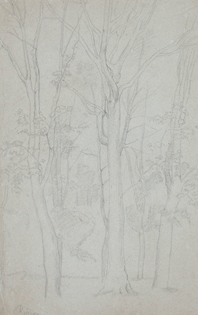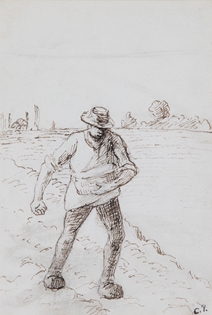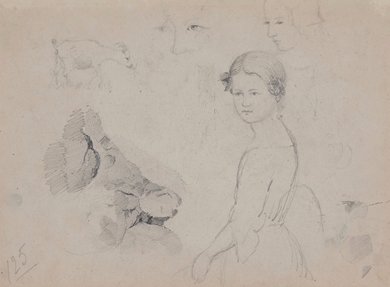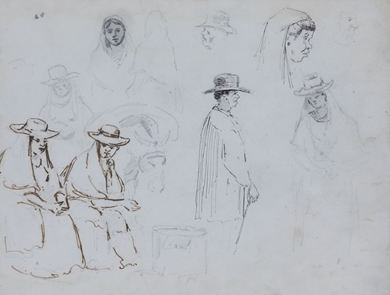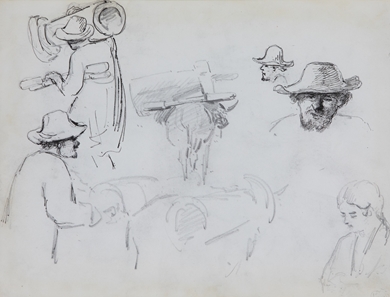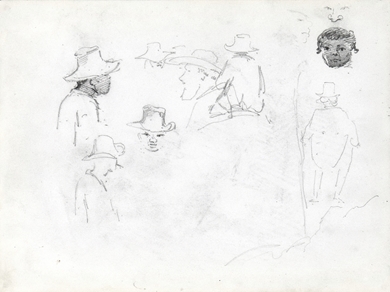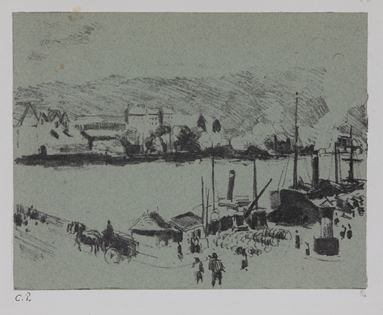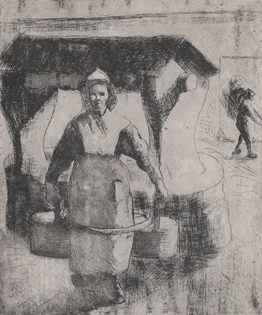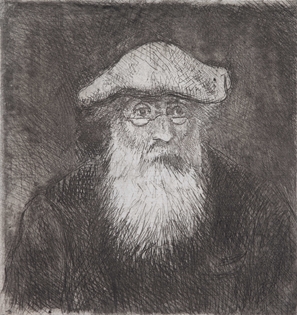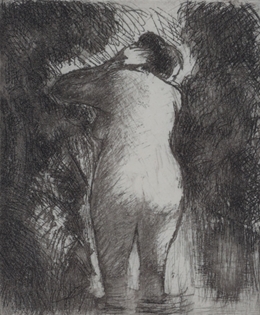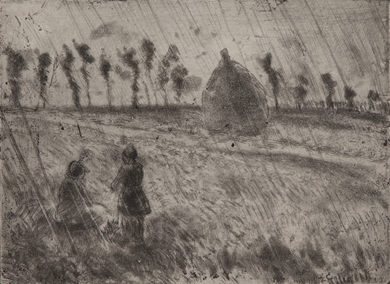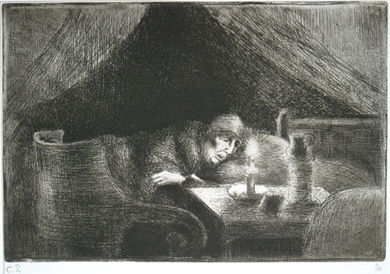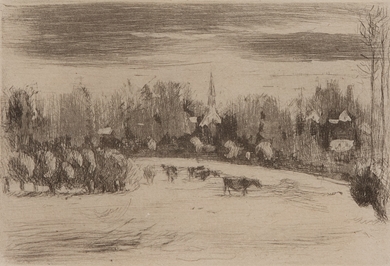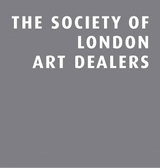Camille Pissarro (1830 - 1903)
- AVAILABLE ARTWORKS FOR SALE
-
Camille Pissarro (1830 - 1903)
La Place du Havre, Effet de Pluie
Oil on canvas
33 x 41 cm (13 x 16 ¹/₈ inches)
Signed lower right, C. Pissarro 97 -
Camille Pissarro (1830 - 1903)
Regent's Park, London
Watercolour on paper
16.5 x 24.5 cm (6 ¹/₂ x 9 ⁵/₈ inches)
Inscribed, signed and dated lower left, C.Pissarro 1890
-
Camille Pissarro (1830 - 1903)
Bords de l’Oise, Environs de Pontoise
Oil on canvas
33 x 41 cm (13 x 16 ¹/₈ inches)
Signed and dated lower right, C. Pissarro 1872 -
Camille Pissarro (1830 - 1903)
Arbres
Pencil on paper
44 x 28 cm (17 ³/₈ x 11 inches)
Signed lower left, C. Pissarro
Executed circa 1859 -
Camille Pissarro (1830 - 1903)
Auvers-sur-Oise
Ink and pencil on paper
30.7 x 46.7 cm (12 ¹/₈ x 18 ³/₈ inches)
Stamped with initials lower right C.P.
(Lugt 613a)
Executed in 1890 -
Camille Pissarro (1830 - 1903)
The Sower
Ink on paper
23 x 16 cm (9 x 6 ⁵/₈ inches)
Stamped lower right, C.P. -
Camille Pissarro (1830 - 1903)
Étude de Minette
Black pencil on paper
28.5 x 45.4 cm (11 ¹/₄ x 17 ⁷/₈ inches)
Monogrammed lower right, C.P.
Executed circa 1867 -
Camille Pissarro (1830 - 1903)
Études de femme, visages, chèvres et rocher
Recto: Études de femme, visages, chèvres et rocher
Pencil, ink, watercolour on paper
22 x 29.6 cm (8 ⁵/₈ x 11 ⁵/₈ inches)
Signed on the reverse three times Camille Pizarro and annotated d'après nature on the lower right
Executed circa 1852
Verso: Études de chèvres, visage et arbre -
Camille Pissarro (1830 - 1903)
Two Seated Women
Black lead, pen and brown ink
20.3 x 26.8 cm (8 x 10 ½ inches)
Executed in Venezuela circa 1852-1854
Verso: Three figures and an ox seen from behind in a landscape, with figures
Inscribed middle-right, anorico
-
Camille Pissarro (1830 - 1903)
A Man Driving Two Cows, a Cow Seen from Behind, a Man Carrying a Churn and Head Studies
Black lead, pen and brown ink on paper
20.3 x 26.8 cm (8 x 10 ½ inches)
Executed in Venezuela circa 1853
Inscribed, Pinco
Verso: A Man Carrying a Load, a Man Washing at a Basin, and Studies of a Woman and Two Cows -
Camille Pissarro (1830 - 1903)
Study Of Men’s Heads
Black lead on paper
20.3 x 26.8 cm (8 x 10 ¹/₂ inches)
Executed in Venezuela circa 1852-1854
Verso: A Farmer Leading Cows, A Cat And Dog With A Study Of A Palm Tree
-
Camille Pissarro (1830 - 1903)
Quai de Paris, à Rouen
Etching
18 x 17.5 cm (7 ¹/₈ x 6 ⁷/₈ inches)
Stamped with initials C.P. lower left and numbered 3/13 lower right
Created in 1896 (printed at a later date as a part of a limited posthumous edition)
Delteil no. 123 -
Camille Pissarro (1830 - 1903)
Quai Boïeldieu, à Rouen
Lithograph
27.7 x 36 cm (10 ⁷/₈ x 14 ¹/₈ inches)
Stamped lower left and numbered lower right, 8/14
Executed circa 1896
Delteil no. 169 (3rd edition)
-
Camille Pissarro (1830 - 1903)
La Rue Malpolue, à Rouen
Etching
19.8 x 15 cm (7 ³/₄ x 5 ⁷/₈ inches)
Stamped lower right, C.P. and numbered 18
Created in 1883-84 (printed at a later date as a part of a limited posthumous edition)
Delteil 53 -
Camille Pissarro (1830 - 1903)
Paysanne au puits
Etching
23 x 19.3 cm (9 x 7 ⁵/₈ inches)
Stamped lower left, C.P. and numbered 8/50
Created in 1891(printed at a later date as a part of a limited posthumous edition) -
Camille Pissarro (1830 - 1903)
Self-Portrait
Etching and drypoint on laid paper
19 x 18 cm (7 ¹/₂ x 7 ¹/₈ inches)
Stamped lower left, C.P. and numbered lower right, 6/22
Created circa 1890 (printed at a later date as a part of a limited posthumous edition) -
Camille Pissarro (1830 - 1903)
Baigneuse Vue de Dos
Etching
8.7 x 7.3 cm (3 ⅜ x 2 ⅞ inches)
Stamped with monogram and numbered lower right, 25/50
Created in 1885 (printed at a later date as a part of a limited posthumous edition)
Delteil no. 3 -
Camille Pissarro (1830 - 1903)
Effet de pluie
Etching, aquatint and drypoint
15.9 x 21.3 cm (6 ¹/₄ x 8 ³/₈ inches)
Stamped with initials C.P. lower left and numbered 7/14 lower right
Created in 1879 (printed at a later date as a part of a limited posthumous edition)
Delteil no. 24 -
Camille Pissarro (1830 - 1903)
Bûcheronnes - Groupe de paysannes
Lithograph on Chinese paper
13.5 x 24.2 cm
Stamped with initials C.P. lower left and numbered 6/18 lower right
Created circa 1896 and produced in 1923 -
Camille Pissarro (1830 - 1903)
La rentrée du Berger
Etching
7.6 x 10.9 cm (3 x 4 ¹/₄ inches)
Stamped with initials C.P. lower left, and numbered 13/18 lower right
Created in 1889 (printed at a later date as a part of a limited posthumous edition)
Delteil no. 82 -
Camille Pissarro (1830 - 1903)
Grand’mère (effet de lumière) (La Mère de l’artiste)
Etching
17.1 x 25.3 cm (6 ³/₄ x 10 inches)
Stamped lower right, C.P. and numbered 8/18
Executed in 1889
Delteil no. 80 (7th edition)
-
Camille Pissarro (1830 - 1903)
Prairies de Bazincourt
Etching and aquatint
8.1 x 12 cm (3 ¹/₄ x 4 ³/₄ inches)
Stamped with initials lower left, C.P. and numbered 3/18 lower right
Created in 1888 (printed at a later date as a part of a limited posthumous edition)
Delteil no. 79
For more available works please contact us on stern@pissarro.com or +44 (0)20 7629 6662.
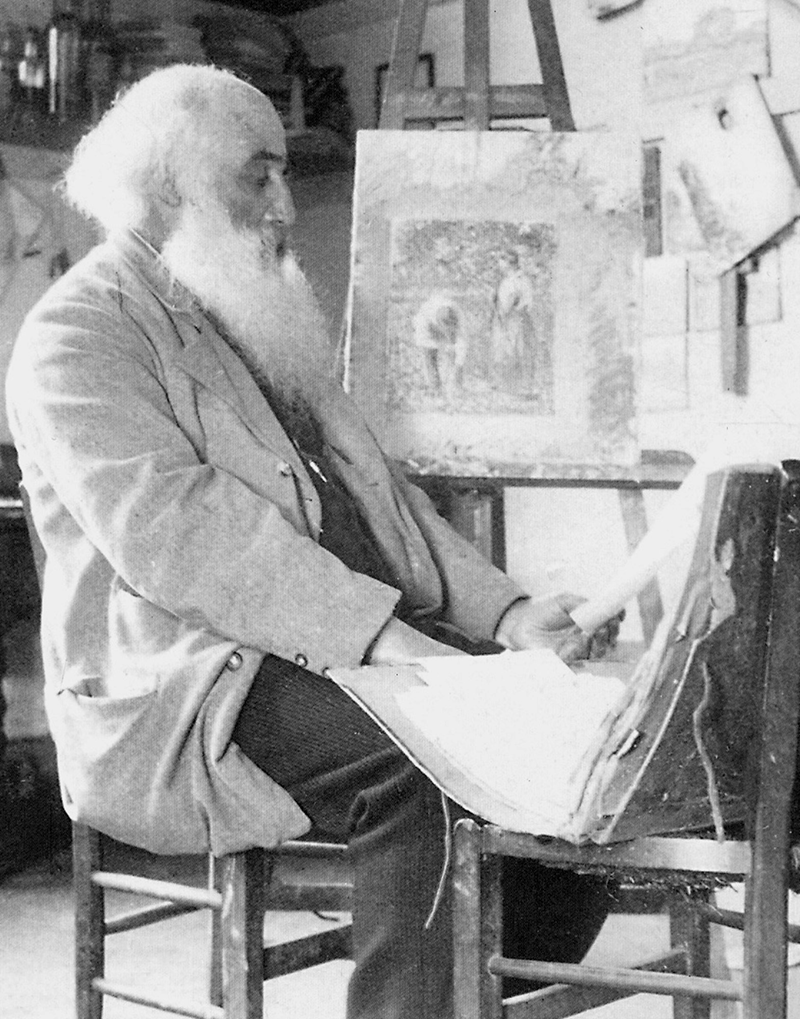
Camille Pissarro was one of the most influential members of the French Impressionist movement. Born 10th July 1830 in the Danish colony of Saint Thomas, Camille was the son of Frédéric and Rachel Pissarro. At the age of twelve he went to school in Paris, where he displayed a penchant for drawing. With his parents disapproving of his interest in art, Camille left the island in 1852 with a Danish artist Fritz Melbye to spend the next 18 months in Venezuela. After a brief return to St. Thomas he moved to Paris in 1855 to study at the Académie Suisse where he would meet many influential artistic figures of the period, including Claude Monet, Paul Cézanne, Édouard Manet and Pierre-Auguste Renoir.
In 1869 Camille moved to Louveciennes. The outbreak of the Franco-Prussian War in 1870 prompted him to relocate to London, where Camille painted a series of landscapes around Norwood and Crystal Palace. At this time, Pissarro and his close friend Claude Monet were able to visit museums together, where they could study and expand their understanding of the tradition of British landscape painting. It was also here that he married Julie Vellay, with whom he would have seven children. Upon returning in June 1871 to Louveciennes, Camille discovered that many of the works he had left in his house had disappeared or become damaged during the Franco-Prussian war.
Camille settled in Pontoise with Julie in the summer of 1871 where he was able to gather a close circle of friends around him for the next ten years. Here he was able to continue building his relationships with Cézanne, Monet, Renoir and Degas, expressing his desire to create an alternative to the Salon. This represented a longing to break from the rigid tradition of French academic painting – Camille believed that he and his peers deserved recognition for the new tradition they were shaping. Cézanne repeatedly came to stay with Pissarro, and under Camille’s influence he learned to study nature more patiently, even copying one of Camille’s landscapes in order to learn his teacher’s technique.
The first Impressionist group exhibition in 1874 earned the Impressionists much criticism for their art. Pissarro was in fact the only artist to exhibit in all eight of the Impressionist exhibitions, with the final one taking place in 1886. Camille’s main subject matter during those years was the rural landscape, wherein great emphasis was placed on highlighting the idealism of life on the farm. Pissarro believed that peasants and their land remained untainted by the corruption of industrialisation. He admired the figures in these rural landscapes, considering their existence and lifestyle to be a symbol of innocence and purity in an age of violent change.
One of the few collectors to show interest in Camille’s work was Paul Gauguin. Having acquired a small collection of Impressionist works, he turned to Camille for advice on becoming a painter himself. For several years Gauguin closely followed his mentor; although their friendship was fraught with disagreement and misunderstandings, Gauguin nonetheless wrote shortly before Camille’s death in 1903: “He was one of my masters, and I do not deny him.”
In the 1880s Camille moved from Pontoise to nearby Osny, before settling in 1884 in Éragny-sur-Epte, a small Normandy village northwest of Paris. In 1885, Camille met both Paul Signac and Georges Seurat after being introduced by his eldest son Lucien. He was fascinated by their efforts to replace the intuitive approach of the Impressionists with the “Divisionist” method, a scientific study of nature’s phenomena based on optical laws. Despite having reached his mid-fifties, Camille did not hesitate to follow the two young innovators. However, after a few years Camille felt restricted by Seurat’s theories and returned to his more spontaneous technique, whilst retaining the lightness and purity of colour acquired during his Divisionist phase.
In the last years of his life Camille divided his time between Paris, Rouen, Le Havre and Éragny, where he continued to explore the varying effects of light and weather in various series of works. Many of these paintings are considered to be amongst his best, with his series of Paris street scenes becoming one of the most collectable themes in his oeuvre. By the time Pissarro died in 1903, his career was flourishing and he had become widely recognised. Today his work can be found in all of the major museums throughout the world.
Read more
In 1869 Camille moved to Louveciennes. The outbreak of the Franco-Prussian War in 1870 prompted him to relocate to London, where Camille painted a series of landscapes around Norwood and Crystal Palace. At this time, Pissarro and his close friend Claude Monet were able to visit museums together, where they could study and expand their understanding of the tradition of British landscape painting. It was also here that he married Julie Vellay, with whom he would have seven children. Upon returning in June 1871 to Louveciennes, Camille discovered that many of the works he had left in his house had disappeared or become damaged during the Franco-Prussian war.
Camille settled in Pontoise with Julie in the summer of 1871 where he was able to gather a close circle of friends around him for the next ten years. Here he was able to continue building his relationships with Cézanne, Monet, Renoir and Degas, expressing his desire to create an alternative to the Salon. This represented a longing to break from the rigid tradition of French academic painting – Camille believed that he and his peers deserved recognition for the new tradition they were shaping. Cézanne repeatedly came to stay with Pissarro, and under Camille’s influence he learned to study nature more patiently, even copying one of Camille’s landscapes in order to learn his teacher’s technique.
The first Impressionist group exhibition in 1874 earned the Impressionists much criticism for their art. Pissarro was in fact the only artist to exhibit in all eight of the Impressionist exhibitions, with the final one taking place in 1886. Camille’s main subject matter during those years was the rural landscape, wherein great emphasis was placed on highlighting the idealism of life on the farm. Pissarro believed that peasants and their land remained untainted by the corruption of industrialisation. He admired the figures in these rural landscapes, considering their existence and lifestyle to be a symbol of innocence and purity in an age of violent change.
One of the few collectors to show interest in Camille’s work was Paul Gauguin. Having acquired a small collection of Impressionist works, he turned to Camille for advice on becoming a painter himself. For several years Gauguin closely followed his mentor; although their friendship was fraught with disagreement and misunderstandings, Gauguin nonetheless wrote shortly before Camille’s death in 1903: “He was one of my masters, and I do not deny him.”
In the 1880s Camille moved from Pontoise to nearby Osny, before settling in 1884 in Éragny-sur-Epte, a small Normandy village northwest of Paris. In 1885, Camille met both Paul Signac and Georges Seurat after being introduced by his eldest son Lucien. He was fascinated by their efforts to replace the intuitive approach of the Impressionists with the “Divisionist” method, a scientific study of nature’s phenomena based on optical laws. Despite having reached his mid-fifties, Camille did not hesitate to follow the two young innovators. However, after a few years Camille felt restricted by Seurat’s theories and returned to his more spontaneous technique, whilst retaining the lightness and purity of colour acquired during his Divisionist phase.
In the last years of his life Camille divided his time between Paris, Rouen, Le Havre and Éragny, where he continued to explore the varying effects of light and weather in various series of works. Many of these paintings are considered to be amongst his best, with his series of Paris street scenes becoming one of the most collectable themes in his oeuvre. By the time Pissarro died in 1903, his career was flourishing and he had become widely recognised. Today his work can be found in all of the major museums throughout the world.

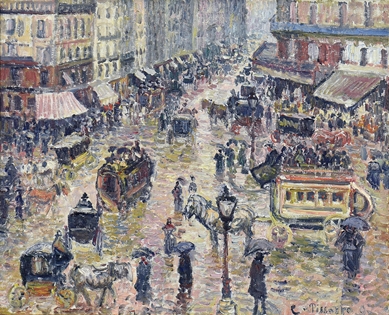

_1932024T135932.470.jpg?w=390&h=315&format=jpg&qlt=100&scale=both)
